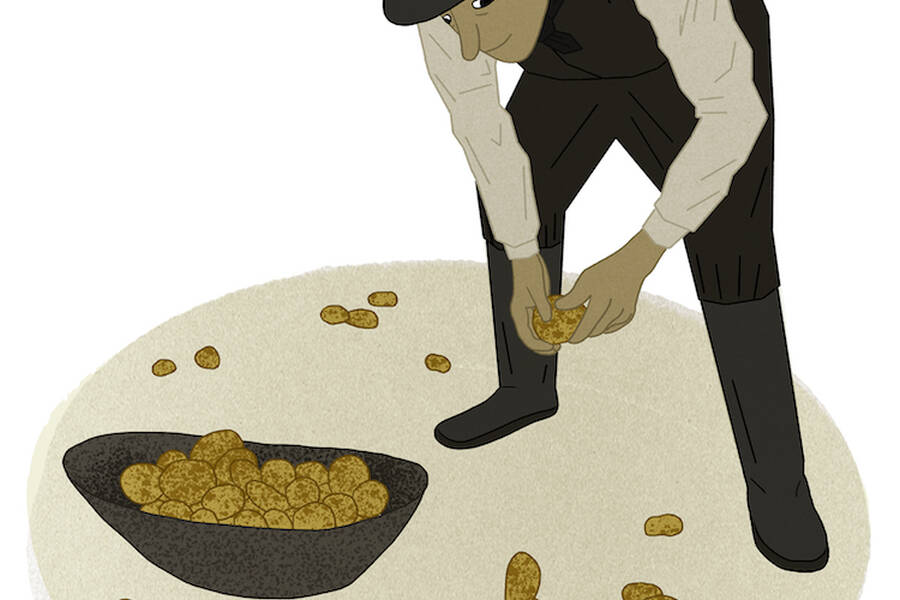Economics Feb 1, 2024
How the Railroad Laid the Tracks for Modern Government
Technologies that allowed federal officials to monitor workers from afar played a key role in the emergence of the bureaucratic state.

Michael Meier
In many countries today, the day-to-day work of government is a kind of perpetual-motion machine. Regardless of who is in power, taxes will be collected, mail will be delivered, and goods will pass through borders.
But bureaucratic states—those organized around rules and administered by nonelected officials—are a recent phenomenon, historically speaking. For centuries, nations (especially geographically large ones) ceded significant control to non-state actors. In so-called tax-farming regimes, for instance, the government or monarch would sell the right to administer and collect taxes in each part of its territory to local landlords.
So, how do modern bureaucratic states emerge?
To find out, a new study charts the formation of the federal bureaucracy in the United States over the course of the nineteenth century. The study by Edoardo Teso, an associate professor of managerial economics and decision sciences, and his coauthor Nicola Mastrorocco of the University of Bologna, was motivated by “a lack of evidence on how a state really evolves,” Teso explains. “We have good data on how bureaucracy and states work today,” but much less information about how those systems came to be.
Their research, which relies on detailed government records, shows that the federal government changed dramatically between the early 1800s and the early 1900s. Not only did it expand in size and geographical reach, it also became more stable and less reliant on personal relationships. Teso and Mastrorocco argue that these shifts stem from the government’s growing ability to monitor workers even when they were far away. These shifts were enabled by new technology, namely, the railroad and telegraph.
“You have a decrease in monitoring costs over the course of the 19th century, because as technologies improve, you have lower transportation costs, and you have lower communication costs,” Teso explains. “As that changes, you can now monitor workers more easily—you don’t have to rely on trust. That also allows the state to grow more.”
A changing federal workforce
Every two years between 1817 and 1959, the U.S. government issued a relatively obscure publication called the Official Register of the United States. The register listed the names, locations, occupations, salaries, and departments of every federal employee. Teso and Mastrorocco stumbled on it “by chance,” Teso says, and quickly realized it offered an ideal way “to peek into the organization of the U.S. federal state in a very early period of its history.”
They digitized editions of the register between 1817 and 1905 and focused their analysis on civilian employees of the executive branch (excluding the branch’s largest department, the U.S. Postal Service). The rich information included in the publication allowed Teso and Mastrorocco to track federal employees’ careers over time and to reconstruct the hierarchy within each department.
The data showed that the U.S. federal bureaucracy looked very different in the first part of the nineteenth century than it did in the second. From 1817 until the 1860s, “we find the state was characterized by very slow growth in the number of people employed,” Teso says. But beginning in the 1860s, the federal workforce grew rapidly. From 1817 to 1859, the federal government added just 235 new jobs per year, on average; between 1881 and 1889, that number jumped to more than 3,000.
States can grow for several different reasons: because they begin performing new functions, because they expand to new geographic areas, or because they increase in intensity—that is, they have more people performing a given function in a given location.
In the early part of the 19th century, the researchers found, the government increased in functions and intensity; geographic expansion was negligible. From the 1860s onward, however, geographic expansion accounted for nearly 30 percent of the government’s growth.
Patterns in workforce turnover changed as well. From 1817 until the 1850s, changes in presidential political party triggered lots of comings and goings in federal government, Teso and Mastrorocco found. During this period, workers’ careers were also likely to advance and decline in tandem with those of their bosses—suggesting that federal offices were organized around personal networks of loyalty and trust. But in the 1860s, these trends began to wane, and workers were more likely to remain in their jobs when their supervisor left or when a new party came into power.
From personalistic to bureaucratic
So, what happened in the 1860s that began to change the federal workforce? Why did it become so much bigger, more expansive, and more stable?
Teso and Mastrorocco argue that an important driver of these changes was the increased monitoring capacity of the state. That is, it became much easier for officials in Washington, DC to check in on workers, regardless of location, and make sure they were doing a good job.
Before the 1860s, meaningful oversight of workers far from DC was all but impossible—some federal offices could only visit their local outposts once a year. Given this limited view, trust was essential to the hiring process; officials typically chose workers who had been recommended by friends or members of their party.
But hiring in this personalistic way is slow. After all, “if you need to hire one person that you trust, you can find it through your network. If you need to hire 50, it becomes more difficult,” Teso points out—hence, the slow growth of the federal government in the early 1900s.
Trains and telegram networks, which fanned out across the country in the mid-nineteenth century, upended old practices and assumptions. Thanks to these new technologies, trips that previously took weeks could take days, and messages that spent days in transit could now be sent in minutes. Now, leaders in DC could quickly and easily observe the work of their far-flung employees.
As a result, Teso and Mastrorocco propose, personal trust became a less-important ingredient in hiring. Officials could select workers based on qualifications and experience, knowing they would be able to spot poor performers more easily than before.
The diminished importance of personal trust also explains why turnover began to dip in the 1860s. Early in the nineteenth century, “when the boss changes, the people that the boss trusts are also going to change. You kick out the old guys and bring in your own guys,” Teso says. But thanks to new technology, “you don’t need to kick everybody out—you can just monitor them better.”
Indeed, Teso and Mastrorocco found that as travel time between DC and a given county decreased, the presence of the federal state increased and employee turnover decreased; they found similar results when they focused on the expansion of the telegram network in a county.
How states grow
Of course, many factors explain why the federal bureaucracy looked so different at the end of the nineteenth century than it did at the start. The Civil War, for instance, shifted power from the states to the federal government; it also left the nation in debt, making it necessary to raise funds via taxation—an important incentive for the federal government to grow.
“We’re talking about 100 years of history,” Teso says, so no one mechanism can explain all the changes the researchers observed. However, he believes monitoring capacity is clearly central to the formation of bureaucratic states. Without the ability to oversee their workers, federal governments are inevitably constrained in what they can do and how they can do it.
This proposition is consistent with “a long literature in sociology that points out that you have the emergence of modern bureaucratic states in Europe, for instance, when transportation costs go down and when communication costs go down,” Teso says.
While the research takes a historical view, Teso believes the findings are applicable to developing countries today—especially those struggling to expand their basic functions to rural and remote areas.
“It may seem obvious, but one of the points of the paper is that transportation infrastructure and communication infrastructure are important for many different things,” he says. “And we show that it’s also important for the way in which state organizations function.”
Susie Allen is the senior research editor of Kellogg Insight.
Mastrorocco, Nicola, and Edoardo Teso. 2023. “State Capacity as an Organizational Problem. Evidence from the Growth of the U.S. State Over 100 Years.” Working paper.



